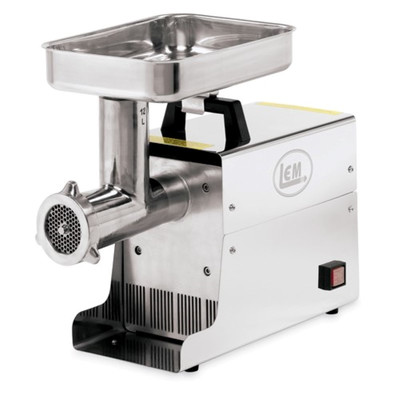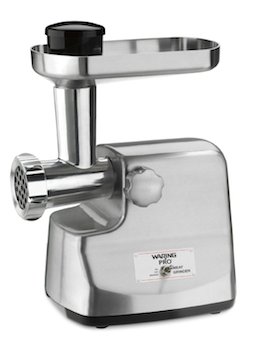In this tutorial, we’re going to discuss the steps that you need to take to grind up tasty hamburger meat. For our burgers, we like to use fresh chuck, but this process also works with meats like lamb, pork, turkey, chicken and game.
We like chuck for burgers because it’s about 15 percent fat, and that usually gives us a perfect balance of flavor without excessive greasiness. This doesn’t mean that you have to use chuck; some people like sirloin burgers, and some people like other meat. That’s part of the beauty of having your own grinder; you can pick whatever you think tastes the best.
Follow these steps to grind a perfect hamburger:
Step 1: Prepare Your Tools
You’re going to need to gather the following before starting:
- Beef
- A couple strips of bacon
- A sharp knife
- Wax paper
- Cutting board
- Your grinder
- Food pusher
- A large bowl
When we buy beef, we like to shop around to find a nice cut of chuck on sale, but in a pinch, any cut of beef will do. Look for meat that is nicely colored and marbled, but don’t get a cut that’s super fatty; if you do, you’re just going to end up trimming it later, and that’s a waste.
Why Bacon?
When you buy commercially ground beef, it’s a mixture of beef, tallow and water. Tallow is a firm and flavorless fat that is found around the spine of a cow, and it helps your meat bind together when cooking. Most people don’t have access to tallow, so we use bacon instead; it holds the burger together, and it gives it extra flavor.
Step 2: Prepare Your Meat
Use your knife to cut off your meat’s excess fat, gristle and silver skin. You don’t have to be obsessive about this, but make sure to get all the big parts. Experienced chefs will tell you that clean meat tastes better when it is ground and cooked.
When your meat is clean, cut it up into small 1 x 1 inch cubes. If you have a small grinder, your pieces may need to be even smaller, but most grinders can handle the 1 x 1 inch pieces.
Step 3: Chill Your Meat
When your meat is cut up into cubes, place it on your wax paper, and then put it in your freezer for about 20-30 minutes. Frozen meat makes the grinding process easier, and it slows down bacterial growth while you are getting set up for the grinding process.
Step 4: Freeze Your Grinding Plates
You might as well put your grinding plate, blade and grinding key in the freezer along with your meat. As we mentioned earlier, cold meat grinds better, and if your grinder pieces are cold, they’ll keep your meat at a stable temperature.
Assemble your grinder when you are ready to begin.
Step 5: Get Ready For Grinding
We like to put a strip of bacon through the grinder at this point. It greases up the inside of your machine, and this results in a better performance. After you have done this, take your meat out of the freezer, and place a large bowl under the grinding plate.
Step 6: Start Grinding
Now it’s time to start feeding meat into your grinder. If your grinder has multiple speeds, follow the grinder’s instruction booklet when it comes to the speed that you need to be grinding at. Feed your meat into the grinder a couple of cubes at a time, and use your food pusher to gently push the meat into your grinder’s hopper. We like to push a strip of bacon through after several cubes of beef; it helps it blend evenly in your meat mixture.
You can also add other ingredients at this time; garlic, onions, cheese cubes and herbs all give your burger a unique and tasty flavor. Be creative with your extra ingredients, but don’t add salt until later when you can judge the flavor better.
Always use your food pusher. You never want to put your fingers or your hands inside of the grinder when it is running. If you have long hair, it’s a good idea to be cautious about it; tie it back or put it inside of a hat so that it doesn’t end up in your grinder.
Step 7: Wait For Your Grinder
Watch what your grinder is doing while it is running; if it looks like your grinder is producing a mushy paste instead of fluffy meat, it may be clogged. If you notice that it’s clogged, turn it off. When it’s off, you can clean out what’s clogging it.
Step 8: Additional Seasoning
When we’re done grinding, we like to season our meat with salt and pepper; some people also like to throw in wet ingredients like eggs, mustard or Worcestershire sauce at this point as well. We eyeball it with the salt; we use a small handful for two or three pounds of meat.
Step 9: Meat Patties
Mix all of your wet and dry ingredients in your bowl, and start shaping your meat into small patties; most people find that a six-ounce patty is perfect for burgers. When making patties, make sure that you don’t pack the meat too tightly; tightly packed meat will produce a tough burger. When you pack your burgers lightly, they’ll turn out light and soft.
Step 10: Cooking
When cooking beef, make sure that its internal temperature always reaches at least 165 degrees Fahrenheit. You can deviate from this temperature when using beef that you have ground yourself since you know what’s in it, but we tend to follow this rule pretty strictly. If you’re making ground chicken or turkey burgers, follow this temperature rule all the time; these meats tend to have more bacteria in them.
When cooking your freshly ground burgers, you’ll notice that they aren’t nearly as greasy as the ones that you make from store-bought ground beef; most people don’t even have to drain their burgers after cooking them. There won’t be any foaming and bubbling during the cooking process because we didn’t add extra water into the meat.
These excellent burgers are hard to beat, and they have a nice smoky flavor from the bacon that we added during the grinding process. They contain high-quality meat, and you avoid the floor scraps, preservatives and chemicals that are added into store-bought ground meat. Grinding your own meat is quick and easy, and once you start, you’ll never go back to the bland burgers that you used to make from inferior store-bought ground meat.


